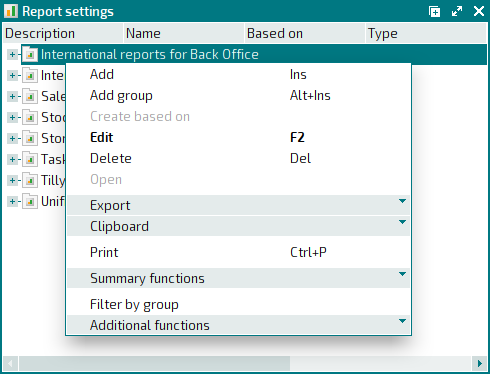© Tillypad, 2008-2015
- Report window
- Access panel in the Report window
- Filter panel in the Report window
- Query panel in the Report window
- Filter settings panel in the Report window
- Model panel in the Report window
- Print layouts panel in the Report window
- Functions panel in the Report window
- Clipboard panel in the Report window
- Report information panel in the Report window
- Print from software modules panel in the Report window
- Report group window
The directory is used to manage configurable reports.
Configurable reports offer you a convenient way to view data on operations performed as well as data about your business’s activities. For example, you can view data in tables, graphs, or diagrams; display it on a screen; or create a print layout and print it out.
Location of the directory: – .
The directory contains a tree list of reports and their groups. Report groups are nodes in the list of reports. Each report group can be composed of reports and other groups of reports. In the data grid, the displayed attributes are applicable only to reports. As for report groups, only their titles - i.e. no other attributes - are made available here. Other report group attributes can be viewed in the directory data grid.

Data grid columns:
Name indicates the name of the report or report group.
Description is a brief description of the report.
Based on designates the baseline report upon which the current report is based.
Security level denotes the security level assigned to the report.
Type denotes the type to which the given report belongs.
Date changed indicates the date when the report was last changed.
System is a tag identifying system objects.
The context menu of the directory contains the following commands:
(Ins) – adds a report to the directory.
The command becomes available if at least one report group exists in the data grid.
(Alt+Ins) – adds a group of reports to the directory.
– creates a report based on another report from the directory.
This command is only available if you select one report.
(F2) – edits reports or groups of reports.
The command becomes available only when you select items of the same type: either reports or report groups.
(Del) – deletes reports and report groups from the directory to the .
– opens a report viewing window.
– menu with the commands to export files into an external file or update package.
– menu with the commands to operate the clipboard.
(Ctrl+P) – generates print layouts.
– menu with the commands to manage the summary functions of the data grid.
– filters by group (for directories with groups).
– menu with the commands to operate the data grid.
The and entry windows are used for adding one or more reports. The and editor windows are used to edit reports.
In order to add a new group of reports to the directory, use the and entry windows. To edit attributes, use the and editor windows.
When you remove reports and groups of reports from the directory, a confirmation prompt appears.
The report viewing window is used to display data contained in the report. The header of this window displays the name of the report.

